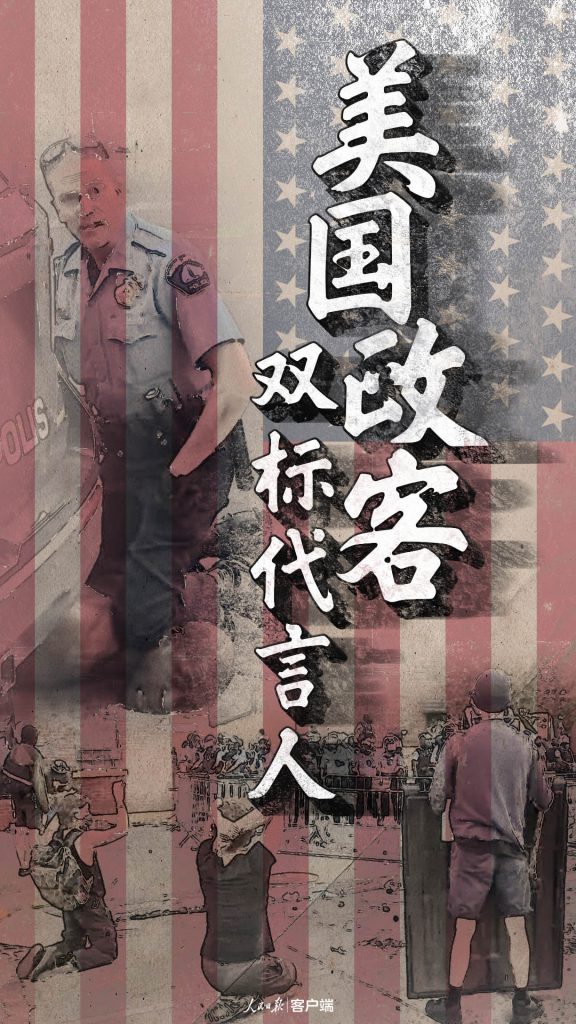Headlines and Hashtags
Is China reveling in US woes?
A number of international media have reported in recent days that Chinese officials might be deriving some pleasure from the protests unfolding in the United States in the wake of the tragic killing of George Floyd. The Guardian newspaper noted Monday that both officials and state media appeared to “revel in scenes of US unrest, comparing protests there to Hong Kong’s pro-democracy movement.” The New York Times reported yesterday that “[as] protests over police violence engulf hundreds of cities in the United States, China is reveling in the moment.”
It is certainly true that Chinese officials are likely to view protests over police brutality toward black people in America as an opportunity to undermine the legitimacy of US statements on the pro-democracy movement in Hong Kong — and on human rights more broadly. Observe the cunning Twitter mastery shown by Hua Chunying of China’s foreign ministry on Saturday as she responded with a simple “I can’t breathe,” the rallying cry for police protests, in response to a tweet in which her US counterpart Morgan Ortagus said that “freedom loving people around the world must stand with the rule of law and hold to account the Chinese Communist Party, which has flagrantly broken its promises to the people of Hong Kong.”

Also cited in several accounts of Chinese schadenfreude over the US protests is Hu Xijin, the editor-in-chief of the Global Times. In one of a number of US-related tweets, Hu equates violence in Hong Kong with the destruction evident on the streets of New York, D.C. and Minneapolis, suggesting the latter must have been incited by Hong Kong “rioters,” who had “infiltrated American states.” Hu Xijin later tweeted with apparent glee: “Mr President, don’t go hide behind the secret service. Go to talk to the demonstrators seriously. Negotiate with them, just like you urged Beijing to talk to Hong Kong rioters.”
French journalist Pierre Haski observed, not incorrectly, for the New York Times: “Beijing could not have hoped for a better gift.” But in the prickly domain of international relations, gifts must be unwrapped carefully. As the comments from Hua Chunying and Hu Xijin make clear, Hong Kong is the issue underlying Chinese criticism surrounding the US protests. And this makes the attention focused on the US both a fortuitous occurrence and an extremely touchy subject for the Chinese Communist Party.
Yes, the US protests can to some extent be exploited as an opportunity by the Chinese leadership. But the leadership must be careful at the same time not to imply the legitimacy of Hong Kong’s pro-democracy movement. It must undermine the idea that the United States stands for the values it purports to stand for – freedom, democracy and human rights – while not quite explicitly advocating those same values.
So, looking beyond the social media barbs of foreign ministry officials and the ever acerbic and often tasteless remarks of Hu Xijin, what are Chinese media saying and reporting about everything happening in the US? In fact, the picture is complicated. Hu Xijin’s Global Times aside – and it should always be regarded as a bit on the side, an antagonistic voice on the periphery of the core – party-state media in China, both central and provincial, have not dealt very loudly with the US protests. This is noticeable especially in the case of newspapers across the country, which have not prominently reported the news, and have tended to avoid images of the protests, especially images depicting more violent acts. Meanwhile, social media platforms, including Weibo and WeChat, which cannot be regarded as state media, have been channels for the sharing of a greater variety of information – including rumour, speculation and commentary. Examples include an interesting on-the-scene report from Phoenix TV correspondent Wang Bingru (王冰汝王冰汝) in Bethesda, Maryland; video of looting at an Apple Store accompanied by foreign media reports citing Apple as warning looters that stolen phones will be tracked; and video of marches in New York City accompanied by the hashtag “#US state governor rejected Trump’s decision to send troops#.” Readers who are interested might consider exploring the Weibo hashtag “American riots” (#美国暴乱#) to get a taste of the information being shared.
But given the suggestion that state media have reveled in events in the US, perhaps it would be helpful to take a slightly more systematic look at how the news is being handled at these outlets. The major caveat I offer here is that there seems to be a marked difference in the information shared by the news apps and public accounts operated by party-state media and the print and online versions of the same media. This begs tougher-to-answer questions about the new ways information, including propaganda, is being processed and shared through digital platforms. The New York Times notes in its report yesterday, for example, that an image titled “Beneath human rights” (人权之下), depicting a cracked and broken Statue of Liberty standing over the White House, was “published by People’s Daily, the Chinese Communist Party’s flagship newspaper, and circulated widely on social media sites this week.”

It should be stressed that this image was apparently created (it is labelled as such) as being from “People’s Daily New Media,” and bears the Sina Weibo tag “People’s Daily.” While the association with the CCP’s flagship newspaper seems clear enough, however, it is not quite accurate, and crosses wires in terms of the media power dynamics at play, to suggest that the image was “published by” the People’s Daily.
As I will discuss in a moment, the graphic message borne by the manga-style image above is something we would expect not to find approximated in the pages of the actual, official People’s Daily, whose discourse is carefully scripted at the upper levels of power. The image is clearly angled toward social media audiences, not toward CCP officials (the primary People’s Daily readership), and designed to go viral. The whole phenomenon of viral propaganda in the digital era, and the differential use of formal propaganda organs versus “official” news apps and social media accounts, is a giant issue deserving much more research (calling all graduate students). To complicate matters further, we must consider the role of Russian and alt-right sources of information both on Chinese state media channels and social media platforms like WeChat, something I will deal with only briefly.
Let’s move on to the traditional, published People’s Daily. The newspaper yesterday included no coverage of the US protests or related commentary. The front page was dominated instead by coverage of Xi Jinping’s plans for a free trade port in Hainan, and with other official CCP business, and most of the rest of the paper was filled with page after page of statutes passed during the recent NPC.
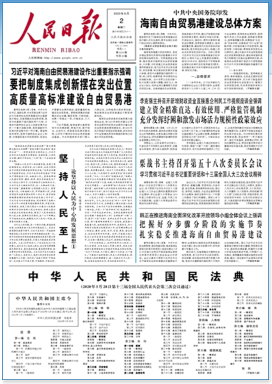
As I said earlier, Hong Kong is the real underlying issue of the moment for Chinese leaders, even as they consider events in the US. And Hong Kong was dealt with in five separate articles on pages 3 and 4. The page 3 commentary was from “Zhong Sheng” (钟声), a pen name used in the paper since November 2008 for important pieces on international affairs on which the leadership wishes to register its view. This column deals with the actions of “certain American politicians” in threatening sanctions against Hong Kong as a result of the proposed national security legislation, and repeats the leadership’s position:
The national security legislation concerning Hong Kong is purely a matter of China’s internal affairs. China’s advancement of relevant legislation is reasonable and legal, and is in the interests of all Chinese people, including our compatriots in Hong Kong. Obviously, some politicians in the United States do not wish to see the long-term stable development of Hong Kong, and they dig about to fabricate various supposed crimes, and threaten sanctions against Hong Kong.
The commentary urges an end to what it calls the “sanctions addiction” of the United States, but never raises US protests. This omission makes sense when you consider the piece’s conclusion, which turns to the need for closer US-China cooperation: “At a time when the COVID-19 epidemic has brought unprecedented public health and economic development challenges to various countries, China-US cooperation to deal with global hardships is of even more prominent importance. The US side should choose to strengthen cooperation with China in areas such as fighting the epidemic.”
A cluster of four pieces on page 4 dealt with Hong Kong national security legislation and the US response, with talk of “the American side blackening ‘One Country, Two Systems’”, the ill-advised nature of the “so-called sanctions,” criticism of Trump’s Friday announcement on barring entry to the US for graduate level research by Chinese nationals with ties to the military.
And what about today? The pattern on the front page of the People’s Daily holds, with an exclusive focus on internal Party business, and there is no mention at all of the United States through the rest of the newspaper, not even in the context of Hong Kong.
When we review yesterday’s provincial-level CCP newspapers, we find the pattern holds again. The Beijing Daily, the official organ of the Beijing municipal CCP committee, makes no mention of news in the US, focusing instead on front-page coverage mirroring that of the People’s Daily, about the master plan for the new free trade port in Hainan. The focus in later pages is on promoting local economic growth, fighting poverty, and NPC statutes. There is even coverage of city policies to deal with waste.
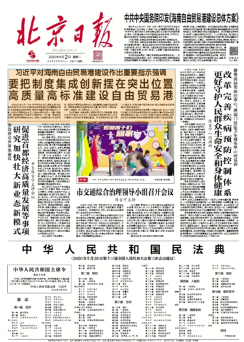
Fujian Daily, the official party mouthpiece of the CCP committee of Fujian province, similarly makes no mention whatsoever of the United States today, the focus again on Xi Jinping’s remarks on the proposed free trade port in Hainan.
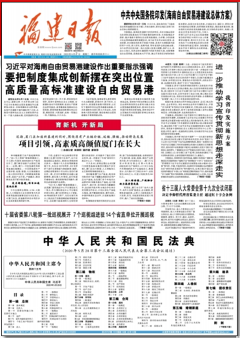
Turning to Zhejiang Daily, the official organ of the Zhejiang provincial CCP committee, the Hainan free trade port news and Xi Jinping’s pronouncements are again the top story. The rest is dry official news that I leave you to read at your leisure.
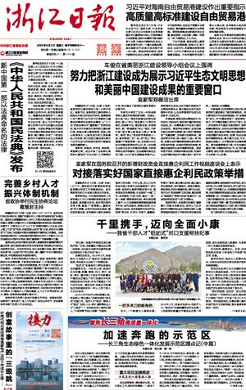
If we turn to city-level papers, the same mind-numbing pattern continues. For example, Changjiang Daily, the official CCP publication in Wuhan, is dominated by the Xi story about Hainan, by the NPC statutes, and by local official news.
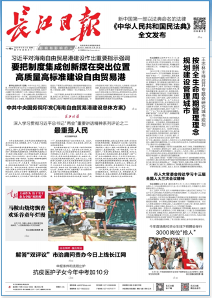
What about the commercial spin-offs of these and other CCP newspapers, which tend to be heavier on news coverage over dry official business? Without getting too deeply into the woods here, I found that the vast majority of commercial newspapers also dealt sparingly with the US protests, to put it mildly. For many, they simply did not exist.
One notable exception was The Beijing News, a commercial paper launched in 2003 by Guangming Daily and Guangdong’s Nanfang Daily but brought directly under the Beijing city leadership as a central-level paper in 2011. The paper addressed the US situation yesterday in two articles, one a commentary (page 3) and the other a news report (page 12). The former, “US riots escalate,” was written by Chen Jimin (陈积敏), a young professor in the International Strategy Research Institute of the CCP’s Central Party School.
After a brief rundown of the situation in the US, including demonstrations accompanied by “violent incidents,” and the dispatching of the National Guard in a number of cities, the commentary focuses criticism on American hypocrisy, the clear goal being to undermine US credibility on its own core values:
This incident is without a doubt a tragedy. Moreover, people sigh to find that it has happened in broad daylight in an America that parades about ‘democracy, human rights, freedom and equality.'” However, a basic understanding of American history will reveal such surprise as naive.
The second piece, a full-page in the “World News” section, focusses on “riots” in the US, bearing the headline: “Over 4,100 protesters already arrested in US riots.” The report is mostly a recounting of known facts, drawing on coverage from CNN and the BBC. The report emphasizes remarks from Foreign Ministry Spokesperson Zhao Lijian, who said this week that “voices of justice from the African Union and African countries represent the general consensus of the international community and he hoped the United States would face them and bide them carefully.” China, said Zhao, is “willing to work with the African side to firmly oppose all forms of racial discrimination, as well as all hateful language inciting racial discrimination.”
China has of course recently had its own serious problems with African leaders over racist treatment of African nationals in Guangzhou, and also faces questions over its treatment of black Americans in the city.
But here we see, notwithstanding, two thematic threads that seem rather consistent in Chinese state media treatment of the US protests – 1) the US has no credibility to speaks on rights and freedoms; 2) China stands with the rest of the world in upholding shared values.

Other commercial newspapers hardly merit attention on the US protests. We note that Guangzhou’s Southern Weekly, typically one of China’s more interesting and professional publications, has no coverage at all of the US on its website today. Providing comic relief, perhaps, the Qianjiang Evening News, a commercial spin-off of the official Zhejiang Daily, would prefer today to devote the front page to explaining why lobster prices are so low. Nowhere does the paper mention the US or other global news.

When we move on to state media news websites, coverage becomes marginally more interesting. The website of China Central Television yesterday included two reports mentioning the US protests – and here is where the question of Russian and alt-right sourcing enters the picture.
The first article, visible in the image below, reported Russia’s RT rejecting supposed claims by former US national security adviser Susan Rice that Russia could be behind the George Floyd demonstrations. In fact, Rice said during a CNN interview with Wolf Blitzer on Sunday: “I would not be surprised to learn that they [the Russians] have fomented some of these extremists on both sides using social media. I wouldn’t be surprised to learn that they are funding it in some way, shape, or form.” Though Rice never explicitly blamed Russia, but rather focused on general disinformation campaigns exploiting divisions in the US, which are well-documented in other contexts, her comments were widely reported to have done so by conservative news sites and Russia media sites like RT and Sputnik News.

The CCTV.com piece clearly cites RT as its only source, and includes a screenshot of RT coverage with Chinese reading: “American politician ‘shifts the blame’ to Russia, and is ridiculed by Russian media.” The piece was re-run at other online outlets, including QQ.com and Hunan’s Rednet.cn, Jiangxi’s official Jxnews.com.cn, Shaanxi’s CNWest.com, the website of Guangzhou’s Yangcheng Evening News, Sohu.com, Sina.com and many others.
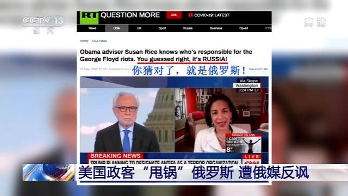
This is not an isolated case of use by official Chinese media of RT and other Russian information apparently emerging from right-wing websites in the West, or similar to content appearing through such channels. On Monday, a number of Chinese websites, including Sina.com, shared an RT story detailing an attack by protesters on a white man identified as a Dallas shopkeeper protecting his neighborhood with a machete. The story originated with Elijah Schaffer, a freelance producer for Blaze TV, the network founded in 2018 by American conservative commentator and conspiracy theorist Glenn Beck. Schaffer apparently edited a video clip of the attack to make it seem unprovoked, and later spread the rumor that the victim had died. Police in Dallas subsequently complicated Schaffer’s version of events, and it seems the man in question suffered only minor injuries, according to the Fort Worth Star-Telegram.
Chinese accounts, most attributed to the Global Times website, reported that “RT quoted an eyewitness as saying that the man who was attacked was trying to protect a local shop from being damaged by demonstrators.” This eyewitness was in fact Schaffer, as the RT article makes clear.
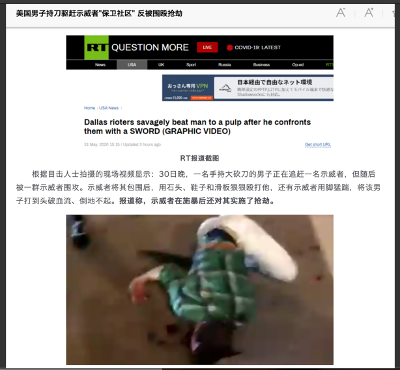
Also this week, the official China News Service shared through its news app a story from the RT for which George Floyd’s aunt, Angela Harrelson, was interviewed by the Russian service. These and other instances on other stories suggest a pattern of use of Russian sources such as RT and Sputnik News across the official sites and accounts of party-state media in China, something warranting further investigation.
The next article related to the US protests at CCTV.com yesterday, “Protests against brutal police enforcement continue to spread in the United States,” is a fairly straightforward account of protests in the US, including the announcement of a curfew by Minnesota governor Tim Waltz and declarations of a “state of disaster” by other states, including Texas and Virginia. The report is based entirely on US reports from CNN and the Associated Press. The image accompanying this CCTV.com article shows protesting figures in a blurry night scene, but depicts none of the acts of violence we have seen in coverage inside the United States and elsewhere in the world – no scenes of street fires and burning flags, destroyed squad cars or burned out post office buildings.
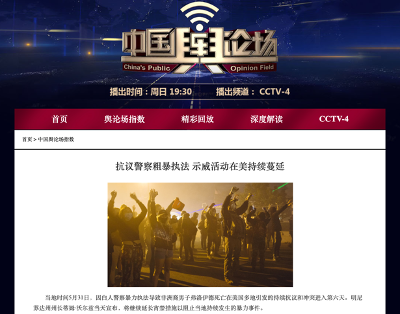
Looking at the use of images of the US protests in state media, it seems that more violent images are largely avoided, suggesting perhaps that such images have been discouraged by propaganda authorities. The scope of this study is of course limited, but Hong Kong could again be a factor here, as authorities are mindful of the resonance images of violence clashes between protesters and police could have.
We can note that an article and video posted to CCTV.com later in the day yesterday persisted in the attack on US credibility over human rights issues, while avoiding more violent images of US protests. The source of the video and story in this case was CGTN America, and a recent special report called, “America: A Reality Check.” The Chinese-language version was headlined, “Six big truths exposing human rights chaos inside the US.” The attack was numbingly familiar: “The United States has always boasted of being a human rights defenders in the world, and has put together its annual country-specific human rights reports in which it grabs at facts and listens to hearsay. But is the human rights situation in the United States really as perfect as some politicians suggest?”
Once again, the basic tactics: 1) undermine US credibility on human rights and basic freedoms; 2) emphasize China’s international solidarity and ostensibly shared values.
These same themes played out on the Chinese-language website of the official Xinhua News Agency yesterday as it shared an image of protests in New Zealand. The focus was on the international outcry over the death of George Floyd, with the implicit suggestion of China’s shared outrage. The headline: “New Zealand protests against violent law enforcement by US police.” Consider the contrast to similar coverage by the New Zealand Herald, which emphasized solidarity with protesting Americans: “New Zealand protesters have today joined thousands of Americans demonstrating against the killing of Minneapolis man George Floyd.”
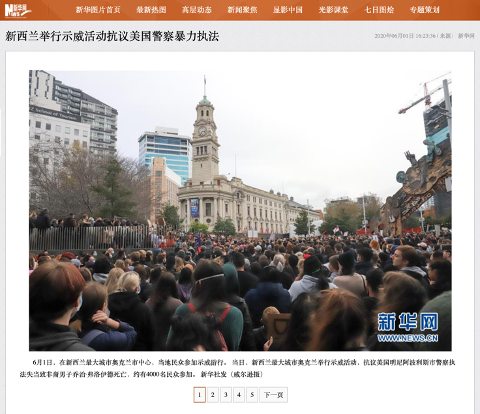
The understated treatment of the US protests in party-state newspapers and on principal websites continues today. People’s Daily Online features no coverage on the homepage today.
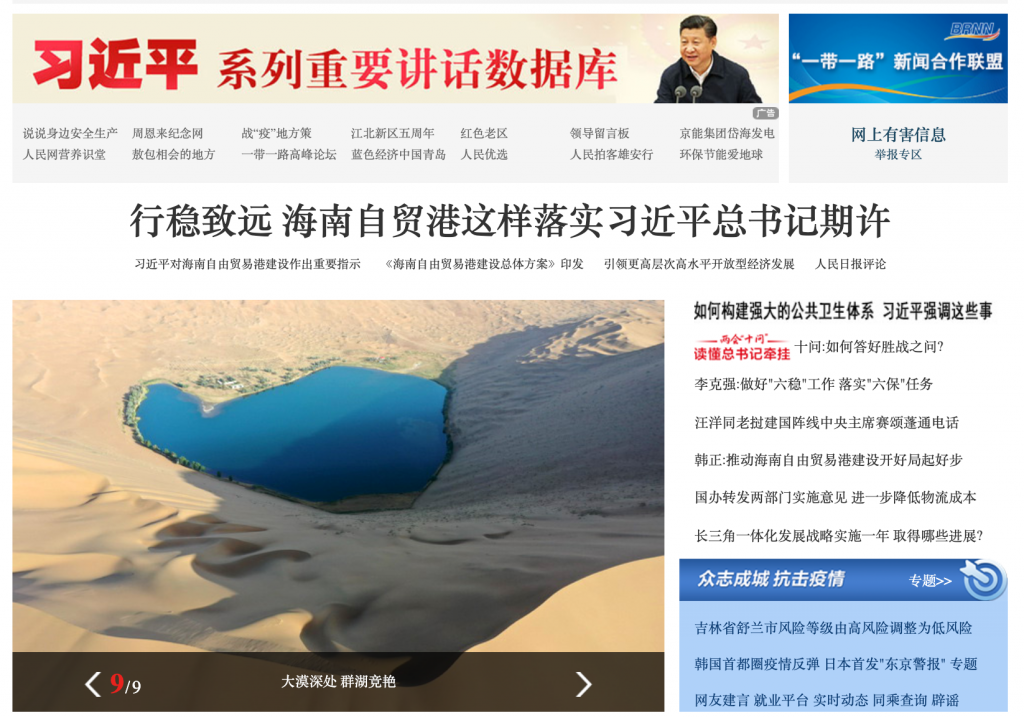
The Chinese-language site of the official Xinhua News Agency, meanwhile, includes a single report with the headline: “Protests against violent law enforcement by police continues in many places in the US, Floyd funeral arrangements finalized.” The report, which does not include statements from China’s foreign ministry or other commentary, begins:
Protests against violent law enforcement by police that have spread across the United States entered an eighth day on June 2, and peaceful demonstrations were held in cities in the south and west. At the same time, the memorial service and funeral of George Floyd, the African-American who was killed by police violent law enforcement, will be held later this week to next week.
In Houston, Texas, tens of thousands of people braved the scorching heat in the city center on the afternoon of June 2 to hold a commemorative parade for Floyd. Before the march, the demonstrators called a brief moment of silence.
Once again, the photos in the news article show peaceful protests, and avoid any display of violence. On Xinhua’s homepage, the story is number eleven, following reports on Xi Jinping’s statements on public health and anti-poverty measures, Carrie Lam’s remarks on national security legislation in Hong Kong, and so on.
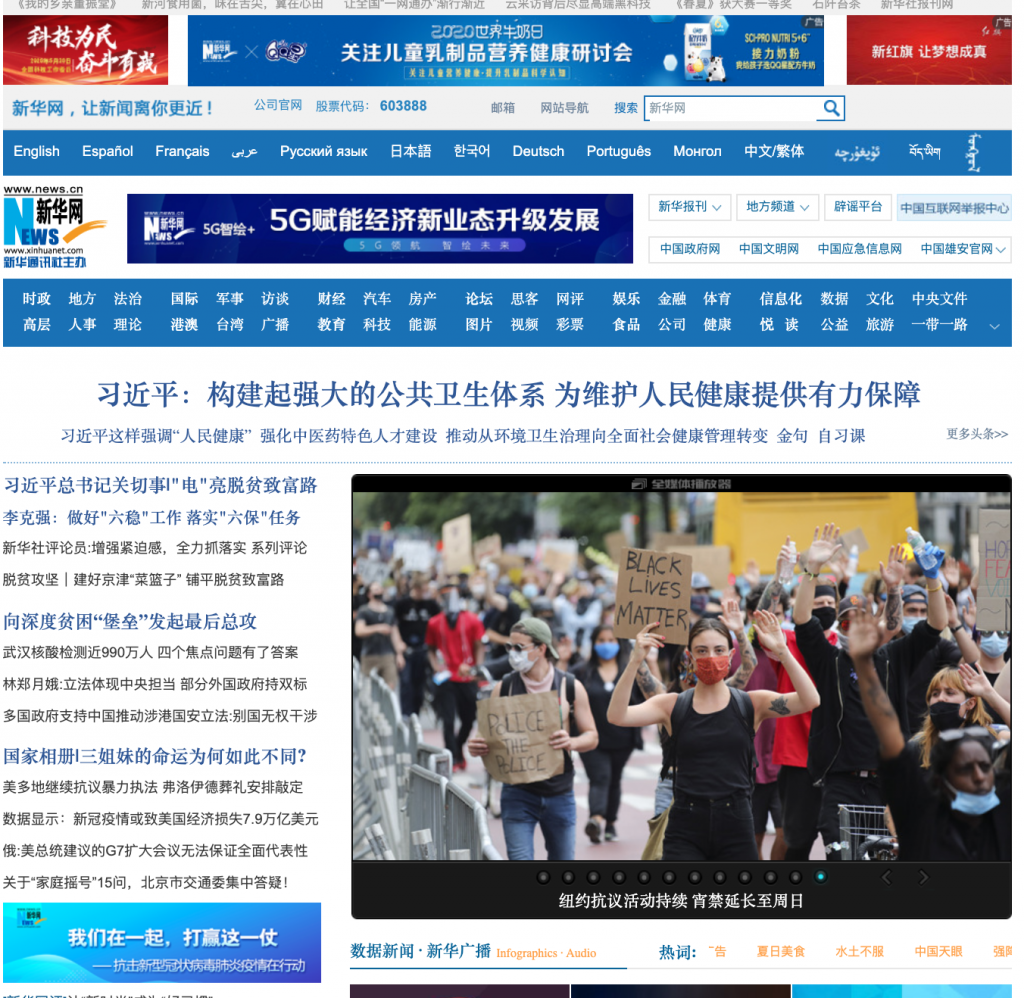
Given the nature of coverage by party-state media, I leave it others to determine whether, in their view, China’s officials are openly “reveling” in the scenes emerging from the US. I would suggest cautiously that the picture is far more complicated. There are clear cases of exploitation, notable for example in the case of CGTN America’s segment on “America: A Reality Check” – which targets an overseas audience but can be reflected back to a domestic audience. There are commentaries like that in The Beijing News, attempting to underscore American hypocrisy, which in any case are featured regularly in Chinese state media, whatever is unfolding in the US. But there also seems to be a muting of coverage in official channels, very possibly because propaganda officials are keen to avoid associations with Hong Kong.
As I indicated at the outset, one of the most interesting contrasts can be found between party publications like the People’s Daily and their digital cousins, notably “People’s Daily New Media.” The latter specialize in digital viral propaganda, and generally they seem to be far more provocative – and perhaps effective? – in their manipulation of the themes I mentioned, including the undermining of American credibility on rights and freedoms.
One further example can be found in a post circulating this week from “People’s Daily New Media” called “American double standards are bankrupt!” The post, which made numerous other sites and apps, including China Daily, Netease, iFeng.com and Yangcheng Evening News, used the words of President Trump to undermine US credibility on Hong Kong.
“When the looting starts, the shooting starts.” Trump said this in response to the violent clashes stemming from the death of a black man caused by a white policy officer kneeling on his neck, and [the president] said the army would support the governor of Minnesota, even threatening to use force against the rioters.
“What people find incredible is that some American politicians actually called the violence in Hong Kong ‘beautiful’”, the post continued. “Now, can such words be turned around on American politicians?”
The post was accompanied, like the crumbling manga-style Statue of Liberty, with an image to help make it viral. It depicted an American flag turned on its side, with an image of a police officer, hands in his pockets, and kneeling protesters. The Chinese headline: “American Politicians: Spokesmen for Double Standards.”
